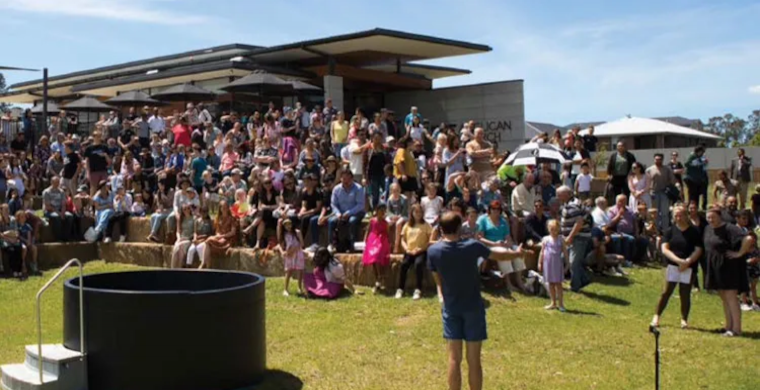Sydney Anglicans Look Westward for Parishes' Futures
An outdoor event at Hope Anglican Church, in the Sydney suburb of Leppington, included a portable baptismal tank.
By Douglas LeBlanc
THE LIVING CHURCH
August 30, 2023
As the Anglican Diocese of Sydney looks to the future of its congregations, it stresses a three-word focus: location, location, location. The Anglican Church Growth Corporation explains this focus in its 2023-2025 Strategic Plan. The 15-page booklet mixes:
• evangelical maxims (one diocesan value is an "urgent love for people who, apart from faith in Christ Jesus, face certain condemnation under the righteous judgement of God");
• corporate jargon ("If we keep doing what we have been doing, we will be too slow in establishing a meaningful presence in growth areas, and too cumbersome in enhancing ministry infrastructure in infill areas");
• and biblical texts ("For from time to time those who owned land or houses sold them, brought the money from the sales, and put it at the apostles' feet, and it was distributed to anyone who had need").
One key point in the booklet is that the population of greater Sydney is moving west of Parramatta, a suburb located 24 kilometers west of Central Sydney.
"The current opportunity for the Gospel in Greater Sydney is significant," the booklet says. "About 1% of Greater Sydney's population regularly attend an Anglican Church in the Diocese. This represents about 48,000 adults amongst Greater Sydney's population of 4.7 million.
"By 2056, the population will have grown to approximately 8.5 million people with 50% of the population of Greater Sydney living west of Parramatta. However, approximately 70% of the Diocesan parish assets (namely, churches) are located east of Parramatta."
The diocese intends to address this imbalance by helping new congregations buy "greenfields" properties in the 2020s, while those properties are still available.
"The way we're operating is to talk to developers when there's still paddocks, and say, 'Where's your space for social infrastructure? We're keen to be in those conversations,'" said Bishop Peter Lin of the diocese's South Western Region in an article by Jordan Baker of The Sydney Morning Herald.
For observers accustomed to thinking of Sydney Anglicans as the bleeding edge of Protestant Anglicanism, the predominance of corporate jargon in the report may be surprising.
Even the report's "Three Big Moves" require occasional translation:
Diocesan Buildings & Property Strategy: The development of a ministry-led Diocesan-wide buildings and property strategy will be a major undertaking to provide long-term strategies to enable buildings and property to better facilitate ministry and evangelism.
Prioritize Greenfields Acquisitions: While it is important to complete construction of the Marsden Park church building, the economic headwinds have caused a shift in our Greenfields focus over the next 3 years toward land acquisition.
Transition URPP to Construction: The URPP [Urban Renewal Pilot Program] has reached the construction phase, so there is a need to transition from project development to also include project construction.
Journalist Jordan Baker helps make the report more accessible.
"[A]t Oran Park, a new suburb on the city's fringe, Sydney's Anglicans were undeterred by emptying pews. When the area was still paddocks, they secured land to build a church, school and aged care home. They were there before most government services," she writes.
"This approach is central to Anglicans' plans to future-proof their religion in an increasingly secular city. They plan not only to preach to Sydney's new suburbs, but to weave faith into their fabric. 'The idea isn't really to come on and impose a church on people, but be part of the community,' Minister Stuart Starr says."
The Diocese of Sydney is the Anglican Church of Australia's largest and most vibrant, by many measures. According to 2015 statistics compiled by David Goodhew, 615 of the church's 2,366 active clergy serve in the Sydney diocese, and it is unique among the church's dioceses in seeing steady, if modest, growth in recent years.
Known for vibrant youth and college-age ministry, the diocese stands out for the youth of its leadership. More than half of active clergy are under 40 and about 60 percent of clergy are under 30.
"Apart from Sydney, the urban Australian dioceses have a serious problem of aging clergy," Goodhew says. "The significance of Sydney within the Australian church looks set to increase in future years due to demography alone."
END














